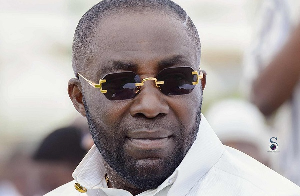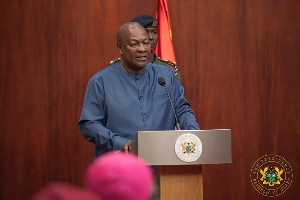DARK STREETS TO SEE LIGHT
… As Gov’t Moves to Pool Funding for Street lighting
By Liberty Amewode, The Business Analyst
Dark streets, which provide cover for criminals to terrorise citizens, would soon become a thing of the past following moves by the government to ensure that all major streets in the country are brightly lit.
Already, a programme to light up all regional capitals has been completed and is being extended to the district capitals.
Consequently, for a period of five years beginning next year, 2012, the Ministry of Energy in collaboration with the Ministries of Finance and Economic Planning (MoFEP) and Ministry of Local Government and Rural Development (MLGRD) shall seek central funding for the development of street lighting. Once installed, the ownership would be assigned to the Metropolitan, Municipal and District Assemblies (MMDAs), which shall be responsible for the repayment of their portions of the loans and maintenance of the street lights. These were contained in a draft policy framework on street lighting in Ghana into which the views of stakeholders from the Eastern, Western, Volta and Greater Accra regions were solicited last week in Accra.
The policy is set to achieve the proper regulation of the installation and maintenance of streetlights and the final draft would be ready for adoption by the end of the year.
According to the Executive Secretary of the Energy Commission, Dr. Ofosu Ahenkorah, who presented the draft policy to stakeholders in Accra, the lack of a comprehensive policy framework on street lighting has prevented a concerted sustainable national development programme for street lighting. He said the weak financial base as well as the inadequate and unavailable technical capacity of the local authorities led to the deterioration of street lighting facilities over the years.
“Given the status-quo, the continued expansion of street lighting programmes will prove untenable in the long term if the required regulatory, implementation, maintenance and management frameworks are not put in place”, he said.
Stakeholder consultations were held earlier in Tamale and Kumasi to cover the northern and middle zones respectively.
Dr. Ahenkorah said in accordance with the pr ovisions of the Local Government (Departments of District Assemblies) (Commencement) Instrument, 2009 (L.I. 1961), MMDAs are responsible for the development, installation, ownership and maintenance of street lights throughout the country, adding that consequently all street lighting constructed by the Public agencies, i.e. Central government, the MMDAs, Road Authorities, and the Community should be transferred to and owned by the Local Government Authorities (MMDAs). He indicated that construction of community street lights shall be sanctioned by the MMDAs, saying that since it was also recognized that some of the MMDAs lack the financial and technical resources to provide and maintain the service, the Ministry of Energy in collaboration with the Ministries of Finance and Economic Planning (MoFEP) and Ministry of Local Government and Rural Development (MLGRD) shall seek central funding for the development of street lighting. “The ability to attract and solicit for external financial resources such as loans and grants is non-existent in MMDAs. The Local Government Act, however empowers MMDAs to impose levies on property and economic activities in their areas or jurisdiction, part of which should be channelled to provide street lights or used as collateral for loans for the development of street lighting projects”, he said.
Streetlight Levy On the mechanism for street lighting levy, Dr. Ahenkorah stated that all electricity consumers shall pay a levy, which shall be adequate, to be used by the respective MMDAs to pay the full cost of energy consumption and maintenance costs of street lighting. He said the level of the levy shall be determined by Parliament at the request of the Ministry of Energy (MoEn) and shall include a mechanism that will automatically adjust the level of the levy in line with changes in electricity tariffs.
Touching on energy consumption charges, the Energy Commission Executive Secretary said all street lighting must be metered as far as practicable to serve as a guide to determine the component of national energy consumption attributable to street lighting and traffic light systems. “The metering will also serve as a guide to an input into the determination of an appropriate street lighting levy to cover the cost of energy consumed by street lighting and traffic lights and to determine amounts payable to electricity distribution utilities for the electricity consumed in street lighting and traffic light systems”, he indicated.
Payment for maintenance
On the payment for maintenance and energy consumptions of streetlights, Dr. Ahenkorah said payment for the maintenance and energy consumed in street lights shall be effected as follows:
1. There shall be one tariff for all street lighting in the country.
2. The tariff shall be set by the PURC.
3. The electricity distribution utilities shall apply the tariff to all street lighting and prepare bills every month.
4. The cumulative bill shall be submitted to the relevant Local Government Authorities (MMDAs), who shall verify and certify the energy charges payable to the relevant electricity distribution utilities for electricity consumed in street lights.
5. The utilities shall keep the certified energy consumption component of street lighting levy to pay for energy consumed.
6. The utility shall pay that portion of the street lighting levy for maintenance to the appropriate MMDA.
The Minister for Energy, Dr. Joe Oteng-Adjei, in a keynote address read on his behalf by Prof. Thomas Mba Akabza , Chief Director at the ministry, said the absence of a policy framework on street lighting has rendered some efforts by central and local governments, including the private sector to expand a street lighting infrastructure that is efficiently operated and maintained, rather ineffective.
He expressed optimism that inputs from the stakeholders would ensure that the policy stands the test of time. thebusinessanalystgh@gmail.com
General News of Thursday, 29 September 2011
Source: The Business Analyst












